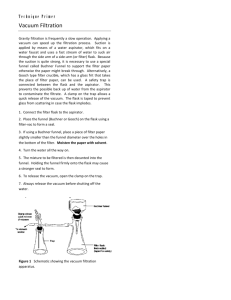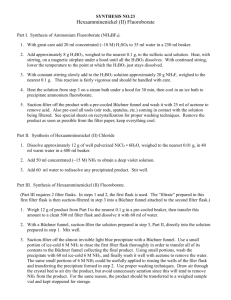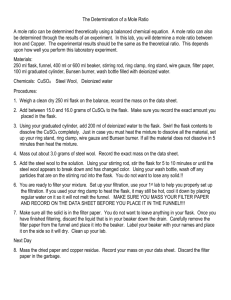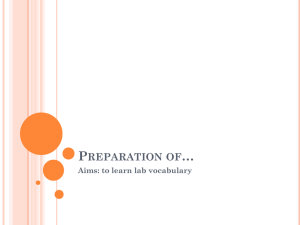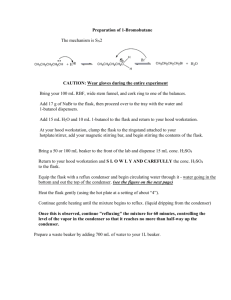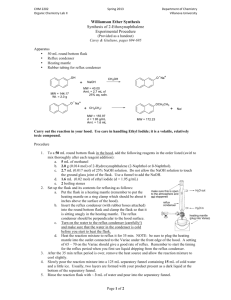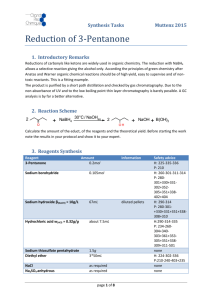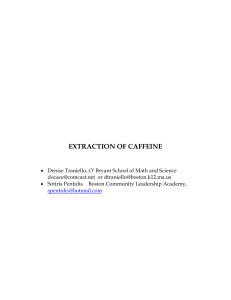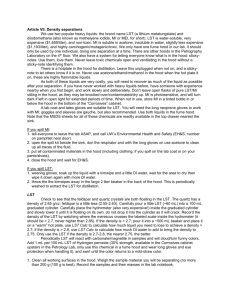waste management
advertisement
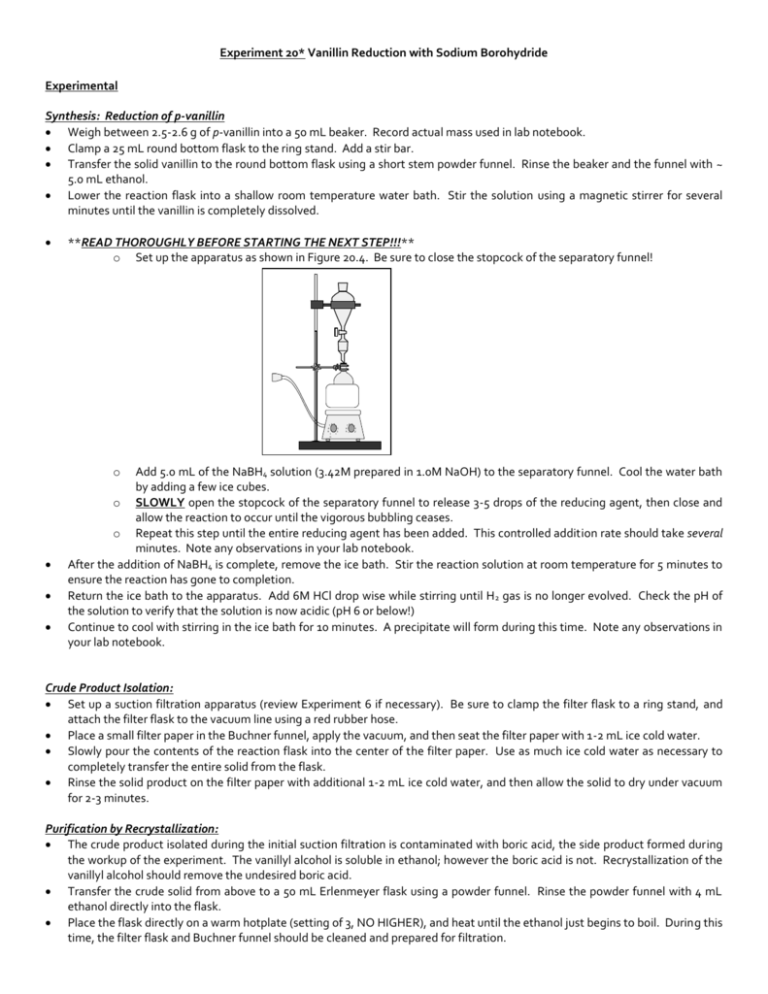
Experiment 20* Vanillin Reduction with Sodium Borohydride Experimental Synthesis: Reduction of p-vanillin Weigh between 2.5-2.6 g of p-vanillin into a 50 mL beaker. Record actual mass used in lab notebook. Clamp a 25 mL round bottom flask to the ring stand. Add a stir bar. Transfer the solid vanillin to the round bottom flask using a short stem powder funnel. Rinse the beaker and the funnel with ~ 5.0 mL ethanol. Lower the reaction flask into a shallow room temperature water bath. Stir the solution using a magnetic stirrer for several minutes until the vanillin is completely dissolved. **READ THOROUGHLY BEFORE STARTING THE NEXT STEP!!!** o Set up the apparatus as shown in Figure 20.4. Be sure to close the stopcock of the separatory funnel! 7 8 6 5 4 3 2 9 1 0 1 7 8 9 6 5 11 4 3 2 1 o Add 5.0 mL of the NaBH4 solution (3.42M prepared in 1.0M NaOH) to the separatory funnel. Cool the water bath by adding a few ice cubes. o SLOWLY open the stopcock of the separatory funnel to release 3-5 drops of the reducing agent, then close and allow the reaction to occur until the vigorous bubbling ceases. o Repeat this step until the entire reducing agent has been added. This controlled addition rate should take several minutes. Note any observations in your lab notebook. After the addition of NaBH4 is complete, remove the ice bath. Stir the reaction solution at room temperature for 5 minutes to ensure the reaction has gone to completion. Return the ice bath to the apparatus. Add 6M HCl drop wise while stirring until H 2 gas is no longer evolved. Check the pH of the solution to verify that the solution is now acidic (pH 6 or below!) Continue to cool with stirring in the ice bath for 10 minutes. A precipitate will form during this time. Note any observations in your lab notebook. Crude Product Isolation: Set up a suction filtration apparatus (review Experiment 6 if necessary). Be sure to clamp the filter flask to a ring stand, and attach the filter flask to the vacuum line using a red rubber hose. Place a small filter paper in the Buchner funnel, apply the vacuum, and then seat the filter paper with 1-2 mL ice cold water. Slowly pour the contents of the reaction flask into the center of the filter paper. Use as much ice cold water as necessary to completely transfer the entire solid from the flask. Rinse the solid product on the filter paper with additional 1-2 mL ice cold water, and then allow the solid to dry under vacuum for 2-3 minutes. Purification by Recrystallization: The crude product isolated during the initial suction filtration is contaminated with boric acid, the side product formed during the workup of the experiment. The vanillyl alcohol is soluble in ethanol; however the boric acid is not. Recrystallization of the vanillyl alcohol should remove the undesired boric acid. Transfer the crude solid from above to a 50 mL Erlenmeyer flask using a powder funnel. Rinse the powder funnel with 4 mL ethanol directly into the flask. Place the flask directly on a warm hotplate (setting of 3, NO HIGHER), and heat until the ethanol just begins to boil. During this time, the filter flask and Buchner funnel should be cleaned and prepared for filtration. Seat a small filter paper with cold ethanol. Pour the contents of the flask into the center of the filter paper to remove the solid boric acid salts. Transfer the liquid filtrate (contains product) to a 150 mL beaker which has been preweighed with 2-3 boiling chips. Place the beaker on the warm hotplate (setting of 3, NO HIGHER), and heat until the solution just becomes cloudy. Remove beaker from hotplate, even if some liquid remains. Remove the remaining ethanol from the product by blowing a gentle stream of air over the liquid. Allow the beaker to cool to room temperature, then reweigh to obtain final product mass. Prepare a TLC sample of the solid by transferring a few crystals to a small test tube, then dissolving in 1 mL reagent acetone. Set this TLC sample aside for further analysis. Prepare an HPLC sample of the solid by transferring a few crystals to a small auto analyzer vial, then dissolving in 1 mL of HPLC solvent (2:3 ethyl acetate/hexane). Set this HPLC sample aside for further analysis. Proceed to Product Analysis with samples. Product Analysis: TLC Analysis Perform TLC experiment on the sample along with the provided standards of p-vanillin and vanillyl alcohol. Develop this plate in 2:3 ethyl acetate/hexane and visualize under UV lamp. Sketch a diagram of this plate in your laboratory notebook. Using tweezers, dip this plate in 2, 4-DNP TLC stain. Blot excess stain on a paper towel, before transferring back to lab hood. Once completely dry, the 2, 4-DNP reagent with produce a dark orange spot with any compound containing an aldehyde functional group. Sketch a diagram of this plate in your laboratory notebook, complete with color descriptions of the spots which appear. Complete Table 20.1 on the final lab report. IR Analysis Using the provided spectra in Figure 20.6, identify all characteristic absorptions of reactants and products. Complete Table 20.2 on the final lab report. NMR Analysis Using the provided spectra in Figure 20.7, identify and tabulate all characteristic resonances of reactants and products. Complete Table 20.3 on the final lab report. Melting Point Analysis After obtaining mass of dry product, prepare a melting point capillary of your dry product. Obtain the experimental melting point of your product and compare to the literature value to determine purity. Complete Table 20.4 on the final lab report. Green Chemistry Analysis Calculate the atom economy, experimental atom economy, “E product”, cost per synthesis, and cost per gram using the equations introduced in Experiment 13. Costs of all reagents and solvents are provided under the chemical equation on the final lab report. Be sure to show complete calculations in data section of lab notebook. Complete Table 20.5 with this data. HPLC Analysis Submit the previously prepared HPLC sample for analysis. Once returned, compare HPLC results of the sample to the provided standard chromatogram. Identify any compounds present in the sample, and quantify compounds present. Complete Table 20.6 on the final lab report. WASTE MANAGEMENT Place all solid waste into the container labeled “SOLID WASTE” located in the waste hood. Place all liquid waste into the container labeled “LIQUID WASTE”. Place any used melting point capillaries and TLC capillaries in the “BROKEN GLASS” container. TLC plates and filter papers can be discarded in the yellow trashcan.
